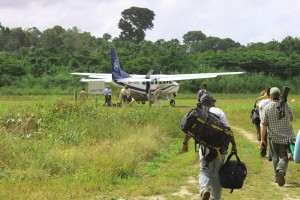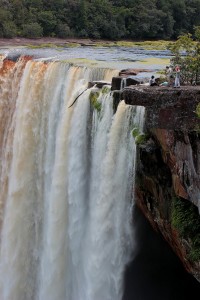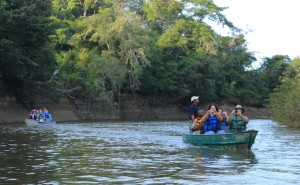[caption id="attachment_7178" align="pull-left" width="300" caption="The group boarding a plane bound for Kaieteur Falls (Kirk Smock)"] [/caption]
[/caption]
GEORGETOWN, GUYANA – According to award-winning travel writer and author Jeff Greenwald, “Guyana is a country just finding its place on the adventurers’ map, and it was fascinating to travel deep into rainforest and meet the Amerindian tribes that have decided that eco-lodges and birding expeditions are a better bet than mining and logging.” Writing on his blog, Greenwald also described the view of Guyana’s forests from an airplane. “It’s a nearly unbroken expanse of green. There are some tannin-laced rivers, and a few spectacular waterfalls, but very few signs of industry.”
Greenwald, who will be writing a story about Guyana for the Los Angeles Times, was one of nine travel professionals from the United States that visited Guyana in February as part of a tourism familiarization (fam) trip. The five tour operators and four travel writers came to Guyana to participate in the eighth fam trip organized by the Guyana Sustainable Tourism Initiative (GSTI), a joint project of the Guyana Tourism Authority (GTA) and the United States Agency for International Development / Guyana Trade and Investment Support (USAID/GTIS) project.
Mike Crewe of the New Jersey Audubon Society came on the trip to research a natural history and birding trip that will be offered to members of the Audubon Society. Crewe said Guyana is “a stunningly beautiful country with so much to do and see for the wildlife enthusiast. Guyana’s strength is that it has so much of the natural world that others have lost…a perfect destination for both birding and general natural history tours.”
Peggy Newfield, owner of the tour operator Latin American Escapes, said Guyana’s strong selling points include “unique culture, pristine wildlife viewing areas, comfortable accommodations and great people.” On the importance that fam trips have when selling and marketing a destination, Newfield added, “The information and experience I received from this trip was invaluable. I feel so much more comfortable now selling Guyana as a destination, and also in my ability to match up the clients to the right product/itinerary.”
As Newfield noted, fam trips are commonly used throughout the tourism industry and they have proven very beneficial in promoting Guyana as a tourism destination. Travelers are faced with endless options when they plan their trips and many look to respected travel writers and preferred tour operators for ideas and suggestions. By bringing these members of the tourism industry to Guyana to experience the product firsthand, it allows – and inspires – them to sell and promote Guyana to the larger market.

The trip, which was co-organized and logistically handled by Wilderness Explorers, made stops at Arrowpoint Nature Resort, Kaieteur Falls, Nappi Village, Yupukari Village, Karanambu Lodge, Rewa Village, Rock View Lodge, Iwokrama River Lodge, Atta Rainforest Lodge and Iwokrama Canopy Walkway, Baganara Island Resort, Guyanese Heritage Museum and Georgetown.
Megan Crewe, a guide with the tour operator Field Guides, said, “I think the country’s biggest draw, for our market at least, is its still-vast wilderness. Add to that the potential for things like Jaguars, Tapirs and hundreds of species of birds, and it’s a pretty attractive destination.” Crewe will work with Field Guides to design a Guyana tour to introduce in 2012; Crewe will also write a newsletter article and post a photo slideshow to market the new tour.
Travel writer Eric Hiss was also impressed with Guyana. When asked to list the strengths of the South American country that he was visiting for the first time, Hiss said, “Undiscovered; incredible eco-opportunities; unique cultural elements; accessibility (similar to the Caribbean).” Hiss is currently working on magazine articles featuring Guyana’s Amerindian lodges and El Dorado Rum, as well as photo essays, videos and blog posts on www.wandermelon.com.
Hiss also commented on the current efforts to develop ecotourism in Guyana, “The idea that government, private sector and USAID are working together to develop tourism in Guyana is encouraging, and in my perspective, really the only type of initiative that can be successful in a developing country.” Hiss hopes that this “will insure all voices are heard, sustainable practices are put in place and all Guyanese will benefit.”
Freelance journalist Amanda Castleman listed the two-day visit to Rewa Village as a highlight. “I loved the dynamic range of this stop, from the school to the [Victoria amazonica] giant water lilies, Golden-handed Tamarin and seeing a Giant River Otter from a dugout canoe. Botany, people and culture took a turn on stage.” Castleman is currently working on articles that will feature many of Guyana’s draws for travelers, like “unspoiled rainforest, unusual flora and fauna, and the cultural intersection of the Caribbean, colonial powers and Amerindians.”

Jim Danzenbaker, a guide with Cheesemans’ Ecology Safaris, will be working to design a tour to Guyana, where according to him the “wildlife viewing potential is great… [Guyana is] beautiful, pristine and uncrowded.” In addition to featuring it on the Cheesemans’ Ecology Safari’s website, Danzenbaker also has plans to give presentations on Guyana to Audubon Societies, local libraries and birding groups.
Kristina Nemeth, Travel Director of the Commonwealth Club of California, provides an important link and insight into the North American educational travel market. Nemeth said she was impressed with Guyana’s “pristine rainforests, conservation efforts and community tourism development.” For her, Kaieteur Falls was the “hands-down highlight. Great views, amazing flight and Guianan Cock-of-the-rock sightings: Perfect.” Nemeth is now planning to do an educational public forum program on Guyana at the Commonwealth Club and organize a tour for 2013.
The GSTI familiarization tours would not be possible if local tourism suppliers were not pledging their full support. For this program, GTA-USAID/GTIS is grateful for the generous contributions from Wilderness Explorers, Arrowpoint Nature Resort, Nappi Village and Maipaima Eco-Lodge, Yupukari Village and Caiman House Field Station, Karanambu Lodge, Rewa Village and Eco-Lodge, Rock View Lodge, Iwokrama International Centre, Atta Rainforest Lodge, Community and Tourism Services (CATS), Baganara Island Resort, Guyanese Heritage Museum, and Cara Lodge.
The Guyana Sustainable Tourism Initiative (GSTI) is receiving support from Guyana Trade and Investment Support (GTIS), a joint project of the Government of Guyana and the United States Agency for International Development (USAID). More information on the GSTI and tourism in Guyana can be found at www.guyana.travel, www.guyanabirding.com and www.guyana-travel.com.
